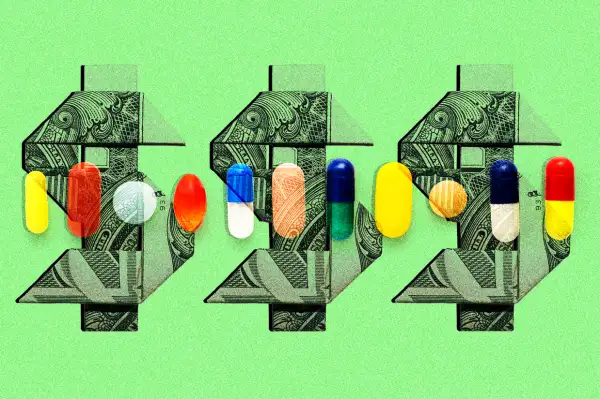Americans Spent $100 Billion on Prescription Drugs in 2024. Why This Year Could Be Worse

Despite new rules aimed at curbing the cost of medication, Americans are spending more than ever on their prescriptions.
Last year, out-of-pocket costs for prescription drugs notched a fresh high of $98 billion, according to a recent report from health data analytics firm IQVIA. Over the previous five years, out-of-pocket costs grew 25%. From 2023, expenses jumped by $6 billion, or 6.5%.
The firm said that a growing number of prescriptions now cost $0 at checkout. Even so, Americans are spending more on the whole due to an increase in prescription drug use paired with an uptick in expenses on costly medications for cancer and weight loss in particular.
The surge in out-of-pocket spending is also due to a disproportionate increase in the cost of prescription drugs administered outside the retail pharmacy setting, such as at hospitals or long-term care facilities. For so-called non-retail drugs, Americans spent $29 billion in 2024, marking a five-year increase of 53%.
Overall, 93% of prescriptions cost $19.99 or less out of pocket, the firm found, with an average price of $9.82. Generic drugs were significantly cheaper than brand-name drugs, at $6.95 per prescription, compared to $28.69.
This record spending is despite new rules that have recently gone into effect to curb drug prices. As part of the Inflation Reduction Act, or IRA, signed into law by former President Joe Biden, out-of-pocket insulin costs were capped at $35 per month for Medicare beneficiaries starting in 2023. And in 2024, additional provisions went into effect that capped prescription drug expenses for certain people enrolled in Medicare’s drug program, known as Part D. Once they hit the “catastrophic coverage phase,” a threshold typically between $3,300 and $3,800 of out-of-pocket spending, the cap kicked in.
America’s struggle to afford medication
Starting this year, the out-of-pocket max for Part D is much lower and simpler: $2,000 across the board. Biden’s IRA also gave Medicare the power to negotiate drug prices directly with pharmaceutical companies. The first round of discounted drugs goes into effect in 2026.
A sweeping executive order from President Donald Trump in April aims to build on the drug negotiation program while encouraging the production of cheaper, generic equivalents of high-cost, name-brand medications, among other initiatives to lower the cost of prescriptions for Americans. Then on Monday, Trump signed another order directing the Department of Health & Human Services to begin negotiating with pharmaceutical companies in an effort to get them to start charging Americans the same low price as the "most favored nation" abroad. Often, Americans pay much higher prices than residents of other countries for the exact same drug from the same manufacturer. Trump suggested that his drug price order — which didn't include specifics on a timeline for the negotiations or the drugs involved — will be used in tandem with tariffs to strike new trade deals.
For many, the relief can’t come fast enough. Over 60% of adults currently take prescription medication, according to a survey by the nonprofit health research group Kaiser Family Foundation, with the most common number of prescriptions per person being four or more.
About 3 in 10 respondents who take prescription drugs said they have difficulty affording them, and the difficulty increases the more drugs the person is prescribed. A similar share said they didn’t take their medication as prescribed at some point in the past year because of the cost.
Instead, many survey respondents didn't fill the prescription, took an over-the-counter drug, skipped doses or halved pills, or a combination of those risky cost-cutting options.
According to the IQVIA report, 96 million new prescriptions in 2024 were abandoned. The more expensive a prescription, the likelier it was to go unfilled.
A drug price feedback loop
Net spending on prescription drugs, which includes the portion covered by Medicare, Medicaid and private insurance companies, is also exploding — up 11.4% in 2024 to $487 billion, according to IQVIA. The firm estimates that total spending will reach $603 billion by 2029.
Zooming out, the spending spree has broader implications for how much Americans end up spending on health care. While it may sound good that insurers — not just consumers — are spending more on prescription drugs, it could lead to more expensive insurance plans overall.
Recent surveys from consulting firms Willis Towers Watson and Mercer found that the cost of workplace health plans is expected to increase between 5.8% and 7.7% in 2025. Employers specifically cited increased costs for weight-loss medications like Ozempic and specialty cancer drugs as major factors.
What's more, these estimations could be conservative, given they were published in the fall — before Trump imposed widespread tariffs. On May 5, Trump signaled that pharmaceutical imports are next, signing an executive order that directs the Food and Drug Administration to impose higher inspection fees for foreign drugmakers. Trump told reporters that more specifics on a pharmaceutical tariff rate are coming later this month.
According to Reuters, a study commissioned by a drug lobbying group found that a 25% tariff on pharmaceuticals, which are normally exempt from tariffs, would increase drug costs in the U.S. by $51 billion annually, boosting drug prices by nearly 13% if passed on to consumers.
In other words, not only could tariffs increase the out-of-pocket drug costs for consumers directly, but the additional expenses for insurers would exacerbate the reason why insurance premiums are already slated to skyrocket in 2025.
More from Money:
On TikTok, Preparing for a Recession Is a Vibe
The Salary Needed to Afford a Home Has Spiked 70% Since 2019
